Metal Gear Solid: Ground Zeroes is the best, most expensive demo ever made
More than zero.
What do you want first: the good news or the bad news? Let's start with the bad, shall we - Metal Gear Solid: Ground Zeroes' main campaign isn't two hours long. For a lot of players it will be even shorter. The good news? After eight hours, it remains fun - if only just.
Let's get the facts out of the way. Ground Zeroes' main campaign is a single mission. Depending on one's play style and a bit of luck, this could realistically be completed in under an hour. Others will take it slow, experiment and maybe start over every time they're spotted. Under these conditions it could last upwards of four hours. It took me about two and a half, when I played it at Konami's camp in Nasu, Japan. But here's the twist: Ground Zeroes' main mission is only a tiny sliver of what the game has to offer.
Upon completing it, you'll unlock four side missions set in the same environment. Some of these are entirely combat-focused, while others are stealth-based. Some flesh out the series' incredibly convoluted narrative, while others are silly one-off scenarios. All range between 15 and 45 minutes, and come with their own truncated end credits sequence as well as the series' trademark cryptic audio easter eggs teasing further plot revelations upon completion. Irritatingly, the two best side missions are split between console-exclusive bonuses and are stupidly difficult to unlock, but more on that later.
Taking these bonus missions into consideration roughly doubles the two-hour playtime, but it's after that where things get lean. Sure, there are banal-sounding trials like competing on the leaderboards for who can tag all the enemies the quickest, and you can tackle harder difficulties or scavenge for hidden trinkets, but there's only so much one map can support before a sense of ennui wears in.

That being the case, Kojima Productions has done its very best to prevent that from happening. Ground Zeroes' sole level is meticulously engineered, and sorting out its secrets remains engaging long past when the end credits roll.
The entirety of Ground Zeroes is set in Camp Omega, a loose yet obvious riff on Guantanamo Bay. Snake has arrived at this mysterious facility to rescue Paz and Chico, a couple of kids Snake met in Peace Walker who have since become followers of the man who will one day be known as Big Boss. On the surface, rescuing kids is an easy enough objective to understand, but if you want further context as to who these children are and why we should care, that info is in Ground Zeroes. Good luck trying to understand it, though.
A Backstory option can be selected from the title screen which offers the longest, most detailed summary imaginable of the plot of Peace Walker (a game I played only a couple of years ago and have completely forgotten the plot details of) and there's a tonne of incredibly lengthy audio recordings that flesh things out even further. At least you have the option to listen to these while skulking about, but if you're able to follow gaming's most convoluted story while avoiding detection, you're a far better multi-tasker than I.
The truth is I tried to persevere through the murky narrative terrain Kojima laid out for us, I really did, but ultimately found it so arduous and at odds with the joy of sneaking that I just couldn't be bothered. Asking a group of Metal Gear fans/journalists at the same event if they actually understood the intricacies of the plot, every one of them offered a sheepish admission they were lost on the specifics. Some argued that it's probably meant to be confusing so that Metal Gear Solid 5: The Phantom Pain can clear everything up. I remain sceptical, but on a basic level we all understood the general set-up for Metal Gear's long-awaited numbered sequel.
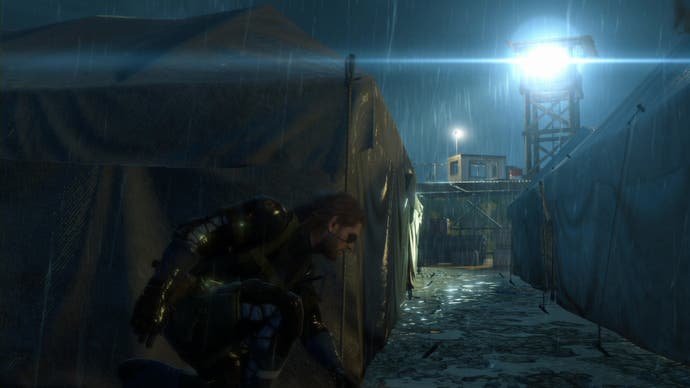
Short and confusing may not the be most ringing endorsement of Ground Zeroes, but the truth is once you get past its micro scale and bewildering back-story, this prelude to MGS5 delivers the goods in ways the series has only hinted at in the past.
Too small to really be considered an open-world, Ground Zeroes is still an open level, with its wide terrain hosting a spaghetti-like pattern of routes devoted to different play-styles. Since your main mission's goal is so simple - rescue two kids - it leaves the player entirely on their own as to how to do this. One of your targets is vaguely marked on your map, while the other is further hidden. It's an excuse to explore the map in further detail.
Like any good Metal Gear, the more you put into it the more you get out of it. Even after eight hours on this map I was still discovering new strategies. I won't spoil them, as figuring these for yourself is much of the fun - but let's just say that Konami capped its preview event by showing a skilled member of the dev team race through the main mission in under 18 minutes without raising a single alert. Naturally, he utilised a lot of secret techniques that hinted at just how deep this rabbit hole goes.
Before you start piecing together its detailed systems, you'll notice that the basic mechanics and design have been minimised since MGS4, a decision that's sure to be divisive. You no longer have a camouflage percent dictating how hidden you are, so you'll have to rely on trial and error to gauge the effect things like darkness and shrubbery have on your concealment. Snake also doesn't have a "stamina" or "psyche" meter this time around, nor does he have a radar. Instead, players must zoom in with binoculars to "tag" enemies, making their movements visible even behind walls.

Elsewhere, the formerly near-sighted enemies are now better equipped for open terrain and can spot you from further away, especially if they're manning searchlights. Further stacking the odds against you, aiming is a lot harder to pull off from a distance as bullets are affected by distance and gravity. In order to get that delicious insta-snooze headshot with your MK22, you'll have to aim a smidge in front of or above an enemy's noggin. Thankfully, the punishment for a missed shot is less severe than it used to be, with foes sometimes attributing a stray tranquilizer dart to a mosquito.
Another neat detail this more open format brings with it is player-controlled extraction points. At any time Snake can summon a chopper to specific landing zones where he can leave the area or deposit POWs. The first time this happens it feels like a scripted event, but by the end of the main mission it shows its true colours as a slice of true tactical decision making. Do you try to clear out a landing zone of its enemy population, or do you try to carry someone to a more remote location further away? Perhaps you'll be able to clear out just enough enemy forces that even if the helicopter is under attack you can make one risky push for it amid enemy fire? If you go with plan C, is disabling the enemy's anti-air turrets enough or should you risk making a scene by planting C4 on that tank? Ground Zeroes' small world is packed with such choices.
Outside of the core game a decision you may be making is which platform to get Ground Zeroes on. Digital Foundry will have the graphics and performance comparison, so I'll focus on each console manufacturer's exclusive bonus missions.
The Xbox One's Jamais Vu mission stars Raiden, who runs a lot faster than Snake, but otherwise operates the same. Your goal in this mission is to eliminate a gang of body snatchers who can only be detected by tagging them with your binoculars. It's a fun little jaunt and it gives non-lethal-focused players like yours truly a chance to muck about with the game's deadlier weaponry, but it's ultimately insubstantial and ends with a frustrating, overly long shooting sequence.
The PS4's Deja Vu mission is the real surprise. In this goofy side-quest you're tasked with recreating photographs of areas in the level that recall the first Metal Gear Solid. Find the right angle to snap a pic of a chopper and two soldiers and the picture is automatically taken, which brings with it a funny cutscene comparing the new game to its 1998 forbear. Like Jamais Vu, it's not a huge boon, but it is an amusing aside for exploration-loving, secret-hunting players like myself.
Unfortunately both console-exclusive missions take a lot of doing to unlock. Konami won't let me say how you unlock them, but let's just say that it's something that would have taken me a very long time to do without outside help. Being the stubborn player that I am, I actually never unlocked them on my file and simply switched demo stations to scope them out.
I'd be remiss to not at least mention one of Ground Zeroes' biggest changes to the series: the newly cast Kiefer Sutherland voicing the lead. It's hard to come to a proper conclusion from this thin slice of content as Snake is a man of few words, but based on his handful of lines I'm not sold on this new interpretation of the protagonist. On a base level, Sutherland's softer, raspier tones sound an awful lot like those of Robin Atkin Downes, who plays Snake's primary compatriot Kaz. This problem makes itself present in the opening cutscene where the two have a conversation off-screen and even after my third viewing of this I had a hard time sorting who was talking at times.
Beyond that, this new Snake - whom I like to call Kiefer Slytherin - simply sounds too human. I've always felt that part of Snake's appeal was due to him being not being a realistic character, but rather an impossibly sexy cipher. Snake was always tough, but never particularly angry or emotional, and I'm not sure there's ever been a more innocent, inquisitive growl than David Hayter's comically one-note take on the character. Snake never behaved like an actual person, but rather an emotionally distant outsider. He was the Man Who Fell To Earth: David Bowie in military scrubs. (And indeed in The Phantom Pain he'll sport a Diamond Dogs biker jacket.)
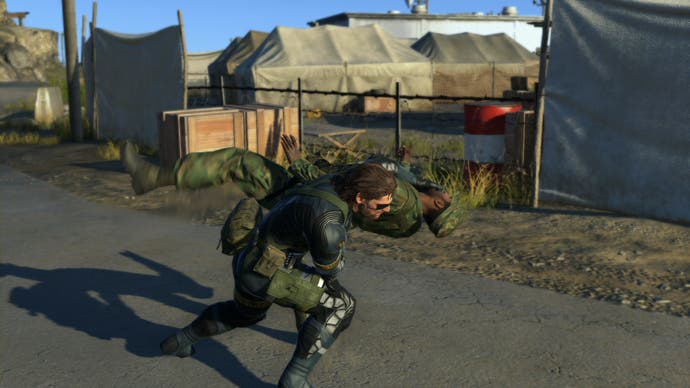
In a lot of ways, there's really a lot to Ground Zeroes. Its small scale is more than compensated for by its robust depth, but its conclusion is anticlimactic, despite its bombastic and lengthy denouement cutscene being exciting in and of itself. Indeed the biggest issue with Ground Zeroes isn't its length: it's a lack of closure.
Gone Home may have lasted a scant three hours, but its conclusion left the player feeling like they'd experienced a full story. Ground Zeroes, on the other hand, doesn't only end in a cliffhanger - much like MGS2's Tanker opening - it doesn't even attempt to spin a full yarn. That mysterious burned man in the opening named Skull Face piques our curiosity only to completely disappear with nary a mention (though he does inexplicably leave behind a seven-plus minute audio recording where he gives a pretentious philosophical monologue to a POW he's torturing). Ground Zeroes may be marketed as a standalone short story, but it's not even that. It's merely a stranded scene or two, floating in isolation for newcomers and lacking in the narrative nourishment series fans expect (despite its marathon hidden audio recordings).
The truth is perhaps that Ground Zeroes was never intended as a standalone release. Konami's always passed it off as an appetiser to tide us over until the main course, but despite The Phantom Pain's gargantuan publisher-backed budget, this feels like a crowdfunding effort in a disguise as obvious as a cardboard box. As Kickstarter has proven time and time again, people are willing to pay top dollar not simply for early access, but because they want to support a project - and the extra money towards the Phantom Pain's no-doubt immense development bill provided by Ground Zeroes will no doubt be appreciated by Kojima and Konami.
So Ground Zeroes is hardly essential, but it accomplishes what it set out to do in giving players a taste of how a more open-ended Metal Gear adventure might feel. Its wealth of strategies and secrets unearth plenty of tactical treasure for those willing to dig - something the premium price deviously encourages. Those expecting a full game are going to be disappointed, however - Ground Zeroes does feel like a very expensive demo. But it's also a very, very good one.
This article was based on a press trip to Japan. Konami paid for travel and accommodation.



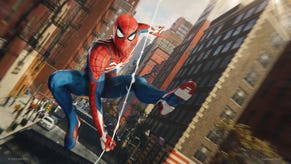
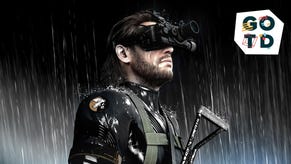
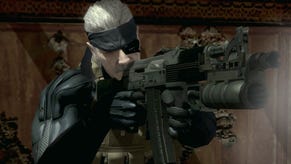
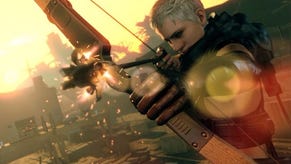

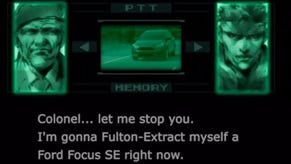
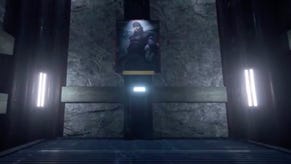




.png?width=291&height=164&fit=crop&quality=80&format=jpg&auto=webp)



